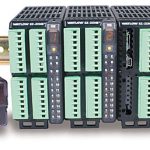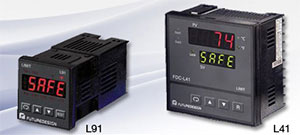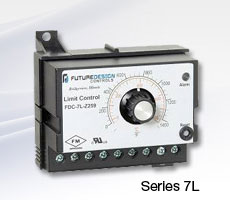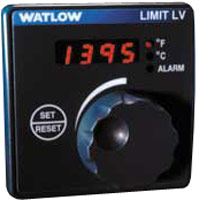
Basic Limit Controller

Digital PID Limit Control

Rail Mount Zone Limit
When Should You Use a Limit Controller?
PTSHEAT recommends a Process Limit Control in an application that is very important. Limit controllers should be used for processes where there is a safety or quality requirement to protect a product or appliance from damage caused by excessive temperatures.
Typical Usage and Benefits
Limit devices are used in process control applications where independent limit switching for over or under temperature is required. If the pre-set temperature limit is exceeded then the output switches to shut down the system. This is a redundant system Loop to protect the primary Process Loop.
A limit control is often used in conjunction with a loop controller. It will generally accept a variety of inputs such as thermocouple, RTD, or process inputs, then allowing for high or low temperature inputs to be set. Limit controllers are used in a variety of applications, particularly industrial ovens and furnaces applications as well as by the life science industry. A limit control should be a FM Approved device for a definite purpose OPEN or CLOSURE output.
One of our very popular limits is the Watlow EZ Zone PM. Panel mount temperature limit. This controller is FM Approved. Used for programmable Process Protection. Set High limit, Low Limit, Deviation limit, or any combination. The EZ Zone Controller is a easy to work with unit that can be ordered / supplied in a Basic version (PM EZ Zone EXPRESS) with limited functions. This will be a control that has less menus for a more simple application. The EZ Zone Controller is also ordered / supplied in an integrated version (PM EZ Zone) with more advanced functions. This will be a control that has more menus and features where you can Set-up advanced parameters for process and temperature management. Watlow controls all come with a standard 3 year warranty. Watlow controls win every award for user friendliness and design.
Our engineers can walk you through the process of selection for the right protection control. We have over 55 years of combined technical support working in the industrial control and process measurement. We design and setup new applications for OEMs and end users. We redesign and help make existing applications better. What is the best control for my process? How can I make this process better? How can I make this process more efficient? If you are asking these questions, then PTS is your source for improved process support!
Here are a few of the LIMIT Controller Options we propose:
Watlow PM PLUS SERIES PID & Integrated Limit Panel Mount Controller
Watlow’s PM PLUS™, the enhanced EZ-ZONE® PM, is now more intuitive and features an enhanced interface for easier programming and readability with a SMOOTH-TOUCH™ keypad creating an industry leading user experience. The PM PLUS is backwards compatible with legacy EZ-ZONE PM controllers but offers many user upgrades including an intuitive menu flow allowing the controller to be easily configured. It also continues to offer the industry leading Bluetooth® connectivity with the EZ-LINK™ mobile app for remote access capability and full descriptions of parameters and error codes. The PM PLUS improves the user experience by reducing the complexity at the front of the control while eliminating the dependency of cables when configuring the product. Like the original EZ-ZONE PM, the PM PLUS can be ordered as a PID controller, or an integrated controller with multiple functions combined into one. Replaces the EZ-Zone PM controller, Series 93, Series 965, Series 96, and ALL brands of panel mount PID controllers.
Performance Features
| Description | Information |
|---|---|
| TRU-TUNE®+ Adaptive Control | Yes |
| Agency Approvals | UL® listed, CSA, CE, RoHS, W.E.E.E., FM, SEMI F47-0200, Class 1, Div. 2 rating on selected models |
| Alarms | Yes |
| Communication Protocols |
Bluetooth
Modbus® RTU
EtherNet/IP™
Modbus® TCP
PROFIBUS DP
DeviceNet™
SAE J1939 CAN Bus
Standard Bus
|
| Control/Limit Loops | 1 |
| Max Output | 15A NO-ARC |
| Mounting | 1/16 DIN Panel Mount |
| Profiling | Yes |
BUY NOW – Click Here to Visit our PTSHEAT Store!!!
Brochure:
Watlow PM PLUS User Manual: PM PLUS PID Integrated 6-8-9 USER GUIDE -12-01-21
Watlow PM Brochure: PM PLUS BROCHURE SELECTION GUIDE
Watlow LV Limit Panel Mount Controller
Watlow’s microprocessor-based temperature limit controller provides an economical solution for applications requiring temperature limit control. Limits are available in a broad range of packaging options, allowing selection of the best version for an application. The temperature limit controller Series LV is available with an operator interface and can be ordered in 1⁄8 DIN-square panel mount or DIN-rail mount design configurations. The variable SERIES LV temperature limit controller includes an operator interface for viewing and selecting the set point. A red, four-character seven segment LED displays the set point. Set point selection is made with a continuous turn rotary encoder. Operating range temperature values are customer defined in the product configuration part number. The temperature limit controllers are factory mutual (FM) approved with special UL® approval for the open board potted versions. Watlow’s limit controllers include industry leading service and support and are protected by a three-year warranty.
Performance Features
| Description | Information |
|---|---|
| TRU-TUNE®+ Adaptive Control | No |
| Agency Approvals | UL®, ANSI, NEMA 4X, 1P65, CE, CSA, FM, RoHS, W.E.E.E. (including potted version) |
| Alarms | 0 |
| Ambient Operating Range | 0 to 70°C (32 to 158°F) |
| Control/Limit Loops | 0/1 |
| Max Monitor Channels | 1 |
| Max Output | 8A |
| Mounting | DIN-rail, Front panel |
| Profiling | No |
| Display Height | 0.28 in. (7 mm) |
| Warranty (Years) | 3 |
BUY NOW – Click Here to Visit our PTSHEAT Store!!!
Brochure:
Watlow LV User Manual: Watlow LV Series user manual
FDC L Series High Limit ControlsL91 & L41

High Limit Controls
L91 and L41 FM Approved High Limit Temperature Controls
- Universal Temperature Input
- Configurable Display Logic – SAFE
- Remote Reset Digital Input
- Simple to Use & Configure
- Up to 2 Outputs
- PC Configurable
- Serial Communications (option)
- Meets NFPA 86.8.16.6 to display temperature and setpoint
Series 7L

High Limit Controls
Series 7L FM Approved High Limit Control
- DIN Rail or Surface Mount
- Compact – Simple – Reliable Design
- Easy to Use
- Remote Reset Digital Event Input
- Dual F / C Temperature Ranges
- Output: 5A Form C Relay (SPDT)
- Low Voltage Power Input available
| L91 & L41 FM Approved Limit Controls – Special Features | |
|
Limit Control Applications:
Protection of process loops when a high/Low temperature or process variable will cause lost heater component, manufactured product, production down-time, or a safety situation.
Controllers
Basic Control
Digital PID Control
Limit Control
Multi-Zone Controllers
HMI
Mold Controls
Control Panels

